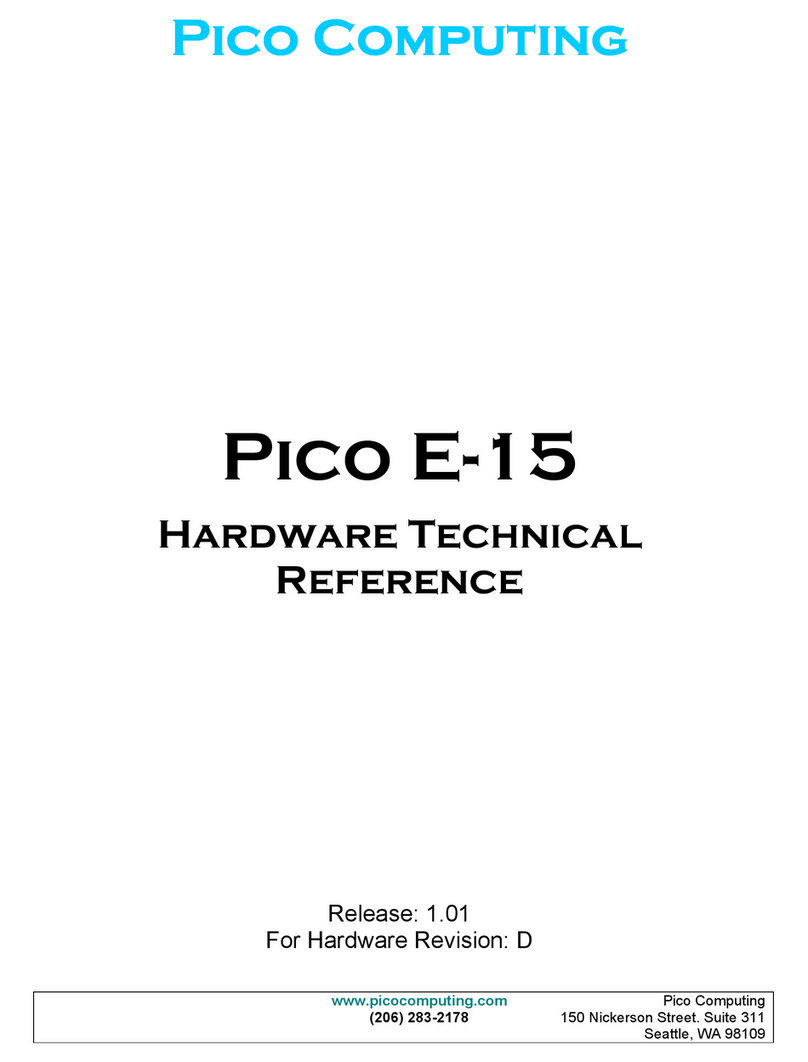
E‐14HardwareReferenceManualwww.picocomputing.com PicoComputing,Inc.
4
Pico E-14 EP Quick Reference Datasheet
Core Technologies
- Virtex-4 FPGA
- PowerPC-405 450 MHz (680 DMIPS)
- 256 MB RAM
- 64 MB FPGA Image Flash
- Analog to Digital and Digital to Analog
Converters
- Gigabit Ethernet (1000/100/10 Mbps)
- 2 RS-232 Serial Ports
- JTAG Hardware / Software Debugging
- 54-bit High Speed Digital I/O Bus
- 16-bit external digital I/O port
- Standalone operation
- JTAG hardware / software debugging
- Open source
Mechanical Specification
- Cardbus Type II
- Stainless Steel Case
- Temperature Range: 0C to +85C
FPGA Performance
- DES > 16 Gbps / 250M Keys / second
- RC4 > 10 Gbps / 12M Keys / second
- > 16 Billion Multiply and Accumulates / second
Typical Applications
- Application on Card (AOC) systems. Vendors
sell their applications packaged with the
platform that they run on.
- Hybrid embedded processor / DSP applications
- Encryption / decryption
- Security algorithms and testing
- Software radio component
- Embedded control systems
- Embedded web servers / applications
- Weight and size constrained environments such
as UAVs, surveillance systems and
environmental monitoring devices.
- Complete development environment for laptop
computers. Ideal for rapid prototyping and
classroom environments.
Analog Capabilities
- 1 High Speed Analog to Digital
- 8 Bit @ 105MS/Sec
- 10 Bit @ 80MS/Sec
- 1 High Speed Digital to Analog
- 8 Bit @ 210MS/Sec
- 10 Bit @ 165MS/Sec
Features
- Complete Cardbus host interface capable of bus
speeds up to 1 Gbps
- DSP capability of the Virtex-4 FPGA
- Bus interface re-configurable to fit other bus nterface
protocols
- Works with Xilinx standard tool set (ISE, EDK, and
Platform SDK)
- Works with Starbridge Systems’ Viva, a graphical
development and modeling tool set designed for
parallel computing and IP portability
- Pico Flash utility for FPGA image and software
executable management. Runs on Windows, Linux,
and Apple Hosts
- Available plug-in for Matlab
- Pico DSP Accelerator / Xilinx System Generator plug-
in for Simulink available
- Available complete board support packages for
PowerPC embedded computing with Xilinx EDK
- Available port of RTCA DO-178B compliant UCOS-II
deterministic / pre-emptive kernel
- Available Linux port
- Available port of Green Hills Integrity RTOS
- Dynamic image swapping: unique design allows for
many FPGA images and user software images to be
stored on the PICO E-14's flash memory at one
time. FPGA and software images are associated
(paired). This allows image sets to be swapped
dynamically. Applications can store data in SDRAM.
This data can then be used by subsequent image
sets seamlessly.




























